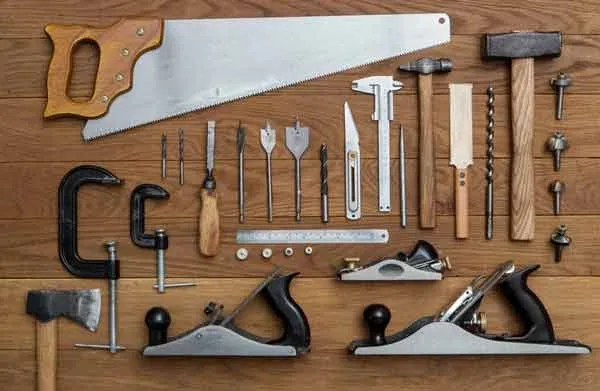
Is it the Carpenter, or is it the Tools?
At the conclusion of a recent Value & Recovery Assessment of a large SYP lumber operation, the General Manager was reflecting on issues that we’d identified around drying quality. His mill runs multiple continuous dry kilns, but they were not achieving the consistency or the drying quality that they were capable of. Drying problems affecting grade and trim in the Planer were often triggering over-reactions at the kilns in the opposite direction: wet lumber issues would become over-drying issues which would become wet lumber issues, etc.
The GM looked at me and asked, “Do you think my current Kiln supervisor is up to the challenge of getting this corrected?”
“What you really need to discover” I replied to him, “is whether your problem is the carpenter, or is it the tools.”
The implication of this challenge is important. In any job, there are two critical elements to achieving success: 1) the skill of the individual doing the job, and 2) the quality of the tools at his/her disposal. The most skilled person cannot perform to their potential if they have no, or poor tools. Likewise, a poorly skilled person cannot accomplish greatness even if they have the best tools available.
As a leader, your success and the success of your organization, will be determined in large part by ensuring that those beneath you have both the skills, and tools, to do their job well. Deficiencies in either will limit what they can accomplish, and frustrate your ability to lead your organization to achieving its potential.
SKILLS
Many wise business leaders have a shared perspective on skills: Hire [or promote] for Character, train for Skills. By starting with a foundation of strong character in your team (things like discipline, dependability, integrity, initiative, enthusiasm, tact, judgement, etc.), you’re already well down the road to success. Once you have the right person in place, your efforts must focus on building strong skills for the task they’re given.
Having strong skills in the context of a manufacturing facility means:
1. Understanding the impact of a given area/ machine/ person/ process on a desired outcome;
2. The ability to diagnose the reason for a poor outcome back to the failure of a specific area/ machine/ person/ process; and
3. Identifying, or guiding others to identify, what to do to correct the failure and get back to the desired outcome.
The easiest of the three steps above is the first. The other two skills (diagnosing and determining corrective action) develop over a much longer time through experience. Rather than waiting on experience, leaders should do what they can to shorten the learning curve through formal knowledge sharing. This could be formal skill-focused classes, access to documented Root Cause Analysis libraries from past failures…and proper Management Tools.

TOOLS
“Tools” can mean a lot of things.
In some cases, this implies a piece of hardware: a physical apparatus that allows for leverage, precision, consistency, power, etc. in order to perform a task. Such tools are critical, and should be readily available whenever a task requires it. Another type of tool is one used to help manage a process: a Management Tool.
A proper Management Tool is something that does two things well:
1. It gathers granular information of all things that can affect performance, consistency, accuracy, and outcome; and
2. It effectively converts that data into visually compelling, easily digested, actionable information.
In my 20+ years in the wood products industry, I can share that most companies have weak Management Tools in some key areas. Generally speaking, their weakness tends to fall into one of the following camps:
1. They track OUTCOME as the measurement for effectiveness, and rely on an area supervisor/manager to simply “know” what’s driving poor performance, and to make it better. The absence of actionable information, built upon the granular issues that drive outcomes, leaves the supervisor/manager “toolless” to know where their problems are actually coming from.
2. They gather LIMITLESS DATA and yet have LITTLE/NO INFORMATION. In recent years, technology has made it possible to track and record a nearly unlimited amount of data from PLCs, Optimizers, scanners, etc. This data is harvested and stored in massive databases, but often the manager/ supervisor must rely on totally inadequate reporting that doesn’t pull that data together into a coherent picture. Data output all too often means a) reams of data to look through and filter for conclusions; or b) a data export to Excel and a mandate to “figure it out”. Most managers/supervisors don’t have limitless time to absorb reams of data, and their Excel skills range from poor (very common) to moderate (at best). Though data itself is an important element of a Management Tool, when data isn’t distilled down to visually compelling, easily understood, actionable information, it can cause “analysis paralysis”, or simply be discarded as too overwhelming.
RECOGNIZING A CARPENTER
That high-volume SYP lumber mill hired Osorno to design and implement new management tools, and develop their staff’s skills, in the areas of Value, Recovery and Downtime. Part of this project involved extensive work in the Kiln area, including development of new Kiln Management tools. The results of the work were dramatic. Drying consistency improved, wet lumber decreased, over-dried lumber decreased, Planer trim loss from drying decreased, lumber gradeout improved, and lumber shrinkage decreased and became much more consistent…allowing the mill to take significant green lumber size reductions and capture additional lumber recovery.
Also noteworthy was the complete confidence that the General Manager had for his Kiln Supervisor. Armed with visually compelling, easily digested, actionable information, the Supervisor was soon able to rapidly recognize issues, diagnose problems, and take continual, small corrective actions that allowed him to achieve, and maintain the outcomes he was responsible for. His skills, previously limited by inadequate management tools, were unleashed. That Kiln Supervisor is now recognized as a confident, highly competent leader… a skilled carpenter.
If you and your team struggle with results, and recognize that weaknesses in either your management tools, or the skills of your staff are limiting your effectiveness, we can help.
STAY TUNED…
This is our 6th article in our series on wood products manufacturing. In the coming weeks and months we will be continuing with more thought provoking articles on all aspects of the business. Look for upcoming articles on Downtime, Production, Maintenance, Leadership, and more.
NEED HELP, OR WANT TO DISCUSS FURTHER?
Our focus is on helping forest products companies identify, and capture the millions of dollars a year that can be lost in each mill through sub-optimal execution.
With more than 20 years of successful experience helping dozens of companies in 15 countries across 3 continents, we can help you too.
Check out our services, and drop us a line. Let’s start a conversation.
HELP US SPREAD THE WORD
If you liked this article, please pass along to your friends by sharing a link to the blog, or sharing this page on LinkedIn or Facebook.
Stay sharp.

